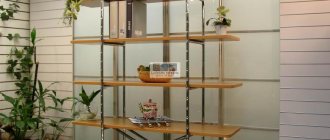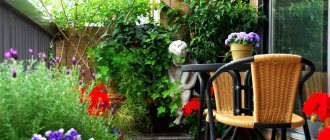For the southern regions, beautiful balconies and terraces entwined with flowers are not at all uncommon. Hanging clusters of wisteria and climbing hydrangea can capture the imagination of the most demanding esthete. But that’s the south, is it possible to design a garden on a balcony in Russian conditions?
Landscape Workshop specialists believe that there is! Even in the conditions of our city, you can achieve a beautiful and blooming balcony, of course, with the right selection of plants and with proper care of the garden on the balcony.
At first glance, gardening a balcony does not seem complicated; everyone probably has experience growing flowers at home, but home gardening and balcony gardening have many differences.
Balcony landscaping options
Landscaping a balcony and loggia with your own hands can be organized according to different principles:
- Horizontal. If you can fit a refrigerator, a bicycle and a couple of strollers onto your balcony, then it’s not a sin to use the space to its fullest. To do this, the room is equipped with various kinds of shelves, tubs and pots with flowers are placed on the floor. The window sill area is equipped with a long box in which fragrant flowers or herbs grow. In this case, the entire space turns into a blooming garden.
- Vertical gardening of a balcony is suitable when the apartment has a small balcony, which can be accessed sideways. In this case, cluttering the space with pots will be inappropriate, as it is unreasonable. In such a situation, it is better if the landscaping is directed upward. Climbing plants planted in compact pots should beautifully entwine the walls and not take up much space. You can see a video example in the photo below.
- Combined. If the area of the loggia allows, and the owner likes the look of woven walls, then you can combine plants for the balcony so that there are pots of flowers everywhere, and at the same time ivy wove around the walls.
- Phytowalls. This is an innovation that is designed for those for whom landscaping a space is not a pleasant pastime, but a goal that needs to be achieved, as well as for those who have time and money to create beauty.
Phytowall (below in the photo) is a wooden wall with special pockets filled with soil, inside which plants are placed. The wall is equipped with an automatic watering system, lamps that turn on by the hour, and does not require special care.
Having studied the ideas for landscaping a balcony, you can choose the right one and begin to implement it.
What containers will the plants be kept in?
If you plan to landscape your balcony, you should not only choose the right flowers, but also choose containers for them. Do not forget that a correctly selected container must match the plant, both in color and shape. The color scheme of leaves and fruits should match the color of the container. It is also important to maintain the general proportions, that is, in the container the flower should not appear too large and not too small. It is also worth remembering that some flowers grow quickly, while others, on the contrary, grow slowly. The leaf part of geraniums can grow a meter over the summer months, while aspidoras can grow one or two centimeters.
Don't neglect the fact that not all pets coexist with each other. Various conditions for fertilizing with nutrient mixtures and watering. Don't take a box and plant all your flowers there. It is better to take a container, fill it with pebbles and place the plants in it in their own pots. Fill the gaps between them with sand and plant a fast-growing flower in them.
Don't forget to securely secure the boxes to the loggia railings. Since even a small pot can lead to an accident if it breaks and falls on someone’s head from a height. The boxes should be secured well so that an unexpected gust of wind does not send them down.
Where is the best place to start landscaping a loggia?
It’s better to start working with stasis by cleaning. Throw away all the accumulated rubbish that has been lying on the balcony for years and is of no particular value. Think about what you can give to those in need and what you can mercilessly throw away in a landfill. Your task is to free up as much space as possible.
- When everything is ready, you need to wash the floor, wipe off all the dust and wash the windows.
- Insulate the space. If it is warm on the loggia, it is easy to make a winter garden from a summer flower garden. To do this, you just need to close all the cracks and put a layer of insulation on the floor. Also make sure that the windows are sealed and do not let in drafts.
- When the area is ready, the last task comes - to think about what kind of vegetation should be placed in the flower garden.
Examples of landscaping an open loggia
An open loggia can be decorated with plants using various options for their placement. At the same time, in choosing flowers, preference should be given to the most resistant crops, because differences in day and night temperatures and changes in weather conditions can negatively affect their condition and viability.
Balcony green outside
One of the interesting ideas is decorating an open balcony with climbing plants. Lianas (both green and flowering) can be spread along the walls from the outside, and it is not necessary to secure structures with boxes or pots from the outside; you can place the containers on the floor near the walls, throwing the vines outside. As they grow, they will need to be secured and trimmed.
You can decorate the entire balcony with bindweed, including the walls of the house itself. The scope for imagination and implementation of ideas is enormous.
Landscaping with evergreen crops
On the open loggia you can plant plants that do not have to be removed when cold weather sets in. Organizing an evergreen corner is quite simple: you can purchase medium-sized coniferous seedlings and place them on the balcony in tubs or pots. Crops suitable for this purpose: thuja, spruce, pine, juniper.
Coniferous crops increase in length quite slowly; this should be taken into account when choosing seedlings. They require almost no maintenance, you just need to take care of watering during the dry season and periodically add soil.
Types of plants for the balcony
If the question arises, which plants on the balcony will look most advantageous, here are the main types:
- The good thing about indoor flowers on the balcony is that they are known to everyone, so there will be no questions about caring for them. The only point is increased attention. In summer - protection from rain and scorching rays, and in winter - from frost and draft. Look beautiful: fuchsia, geranium, begonia, aloe, chlorophytum, etc.
- Curly ones are good not only for their aesthetics, but also because they protect the room from the sun and dust. You just need to tighten the threads along which the lashes will begin to stretch upward. Pay attention to sweet peas, clematis, creeping beans, decorative beans and others.
- Ampelous varieties are usually planted in hanging pots. Their peculiarity is hanging shoots, which require special watering and calculation of the mass so that the flower does not fall off the chain. In the absence of a special tray, liquid can drip onto the heads of passers-by and owners. Options: petunia, ageratum, lobelia, pelargonium, godetia, verbena, etc.
- Spices. Landscaping a loggia can be not only beautiful, but also useful. Fresh, sometimes rare, spices that can be added to food will appeal to every housewife. These options could be: dill, balsam, lettuce, parsley, rosemary, thyme, etc.
The location directly depends on the cardinal direction relative to the sun on which the loggia is located.
What new flowers should you buy?
After indoor pets have been moved to the balcony, you should think about what annual or perennial flowers can be purchased for the loggia. The best option, of course, would be to plant perennial plants, as well as those that retain their bright leaves and have a compact leaf structure.
Today, one of the most common plants on the loggia is petunia. There are many varieties of it, having both an erect stem and hanging varieties. It is worth remembering that its large hybrids do not tolerate raindrops falling on them - they close. But the very next day they open up again.
The queen among beautiful plants grown in containers is the tuberous begonia. It has various shades of fruits - pink, white, yellow and others. It begins to bloom in May and pleases with its beauty until the first cold days. During winter, its tubers are placed in sand.
Impatiens blooms with the arrival of warmth and until autumn. As soon as cold weather sets in, the plant can be moved indoors. Cuttings should be taken in March.
Calceolaria begins to bloom on the balcony with bright yellow flowers in late spring. In winter it is in the room. It propagates in the same way as balsam, by cuttings.
A distinctive feature of coleus is that on the loggia it outshines other plants with its brightly colored leaves. They are planted in May, and within a month a bush with a mosaic structure of leaves grows. Cuttings are carried out in August. In winter, the plant is kept in a warm room with plenty of light.
An insulated balcony is good because you can plant Erica on it, which blooms throughout the cold season.
Containers for planting vegetation on the balcony
It is better for the plants on the balcony to form a complete composition; different containers will serve this purpose:
- Place the pots on wooden or wrought iron stands.
- In open areas, use hanging pots or baskets.
Important! Make sure the boxes are not too heavy. In addition, you can paint the containers with bright colors or decorate them using the decoupage technique.
- Dilute the decor with candles and figurines, and pots with beads, stones or paintings.
- You can make containers with your own hands. To do this, you can use tin cans, bottles or other garden tools.
Houseplants that can and should be moved outdoors
To arrange a garden with your own hands, with the onset of spring or warmer weather, you should move some indoor pets to an open space. Here they will have better conditions - plenty of sun and acceptable humidity. Everything is like in nature. However, there are also disadvantages - if the room is located on the south side, the sun will be very hot, rainfall will spoil the plants, and the wind can break them. It is better to transfer plants there that are easy to care for, such as geraniums, fuchsias and aloe.
A balcony located on the western or eastern side is suitable for almost all plants, since the sun appears there only at dawn and dusk. Hydrangea is one of these flowers.
The north side is completely unsuitable for sun-loving flowers - there they will grow very sluggishly. However, the southern side is also dangerous for them due to the scorching sun.
Cacti thrive in such conditions.
Features of caring for plants on the loggia
Caring for flowers planted on a loggia is not difficult, the main thing is to remember its main components. Watering differs depending on the type of greenery. Feeding is required on average once every 2 weeks.
Loosening provides oxygen access to the roots. You need to loosen carefully, but often. Removal of excess leaves should occur regularly.
High-quality flooring is the key to success
To fix artificial grass on a loggia or balcony, you need to prepare the base. When installing the base, take into account that the landscaped balcony is a source of high humidity; it is also important to understand that it is impossible to do without thermal insulation of the balcony slab.
Stages of work to prepare the base for artificial turf on the balcony:
- The concrete base is inspected. Slots and cracks are sealed with cement-sand mortar and primed.
- A waterproofing membrane is laid on the slab.
- Logs are laid on top of the membrane under the wooden floor.
- Install insulation.
- A foil film is laid over the insulation.
- The floorboard is attached.
- The floor surface is primed and covered with varnish or paint.
Such a base will retain heat well, preventing cold air from entering the garden on the balcony, and if it gets on the surface of water, it will not deteriorate. How to properly lay artificial turf on a balcony. To attach the lawn to the surface, use silicone sealant or simply fix the perimeter with self-tapping screws to the wooden floor boards.
The artificial covering for landscaping is pre-cut to size in order to cover the entire space with one sheet.
DIY step-by-step guide
Landscaping of balconies using artificial turf is carried out as follows:
- Before starting to cut the material, the roll is rolled out on a flat surface. It takes at least 10 hours for the lawn to rest and acquire the desired shape;
- the leveled sheet is cut to the size of the flooring on the balcony or loggia;
- before starting work, you need to remove all things from the balcony to free up the area for installing the lawn;
- the covering is again rolled up and brought onto the loggia. Laying begins from the far wall. Sealant or other adhesive is applied in strips 20 mm wide in increments of 15-20 cm. The lower surface of the roll is pressed against the glue and rolled out to the opposite wall, while constantly adding adhesive strips to the base;
- After completely gluing the artificial landscaping to the floor, you need to lightly tap the entire surface with a rubber mallet to ensure reliable adhesion.
You can use the coating after the adhesive mass has completely dried, in accordance with the instructions.
How to organize a winter garden on a loggia
Loggia landscaping is beautiful not only in summer. In winter, you can also have a beautiful green garden that will create the feeling of an everlasting spring. To create a winter garden you need very little:
- Heating. For normal plant life, a temperature of at least 20 degrees is required, so for a winter flower garden, buy a heater that will constantly work during the cold season. Avoid the appearance of cracks and drafts.
Important! You cannot use homemade heating structures, as this poses a fire risk.
- Humidity. Flowers consume moisture not only from the soil, but also from the air. Invest in a trouble-free humidification unit.
- Lighting. Additional lamps may be needed to help with long winter evenings.
The advantages of creating a winter garden:
- protection from rays on the sunny side;
- aesthetic appeal;
- the ability to grow spices;
- an opportunity to relax after work.
Vertical potted garden
By attaching fasteners for flower pots to the balcony wall, using multi-level stands, different variations of hanging multi-level shelves, you can create a flowering wall of dozens of pots on the balcony wall.
Today, the choice of “attached” structures is very large. Narrow racks, ladders, shelves, racks, which are often a work of art with forged elements, old stepladders or shelves will help to place plants no worse than “hooks” and brackets with circle stands for pots, and other hanging holders of different sizes and shapes. You can place a series of plants not in containers, but in bags made of canvas or thick fabric, in improvised containers (for example, old tins or an old set).
Of course, there are purely practical limitations in the possibilities of placing large quantities of flower pots on the wall - from the possibility of using reliable fasteners to the stability of materials and the ability to drill holes. Attached shelves simplify the process, but they also need to be securely fastened to prevent the structure from tipping over.
Not every balcony will allow you to hang a dozen pots on the wall. For this option of vertical gardening, be sure to select small, lightweight containers and a very light substrate and drainage in order to reduce the maximum load on the structure.
For potted vertical gardening, be sure to select small, lightweight containers. © Champsbahrain
Choosing Plants for a Vertical Potted Garden
Petunias, pansies and marigolds are the absolute favorites for decorating balconies. But when doing vertical gardening, it is worth considering the growth form of the plants. Ampelous plants with hanging shoots, capable of creating beautiful cascades, are the best choice. Today, even marigolds, pelargoniums, balsams, and begonias have such varieties.
To achieve a particularly striking effect, it is worth combining ampelous plants with bushy ones in complex combinations, which will give the flowering wall from different pots additional volume.
For walls composed of several hanging balcony boxes located one below the other, staggered pots with summerhouses, or a potted garden located on a narrow rack, the choice of crops is carried out based on lighting conditions:
- On the eastern and western balconies, a charming vertical garden can be created from pelargoniums, balsam, begonias, petunias, lobelia, brovallia, bacopa, diascia. Any indoor plants that can be taken outdoors in the summer will feel great here.
- On southern balconies, heather and erica, catharanthus, gerberas, ampelous violas, marigolds, nasturtium, gillyflower, ageratum, carnations, phlox, the same pelargoniums and petunias of hardy small-flowered varieties are more appropriate. Even ampelous strawberry varieties can perform an impressive vertical task. Among indoor plants, cacti, dracaenas, yuccas, agave, laurels, citrus fruits, and aloe can be brought here and used in a vertical garden on a rack or stand.
- On the cooler north side of the house on the balcony for a vertical potted garden, it is better to choose shade-loving indoor plants - ferns, fuchsias, tradescantia, ivy, cherry laurel, aspidistra, cissus. But the choice is not limited to them. Forget-me-nots and mignonette, begonias and marigolds, balsams and coleus will grow on the northern balcony.
If you decide to decorate an open balcony that does not have protection from the wind with a vertical potted garden, then special attention should be paid to the stability of the structures. But pilots also need to be selected more carefully. Calendulas, ageratums, begonias, verbenas, annual asters, chrysanthemums, and gazanias grow well on windy balconies.
In order for such a prefabricated potted garden, placed not in a horizontal, but in a vertical plane, to remain attractive throughout the year, we must not forget to add potted accents to the main gardens. Bulbous and small-bulbous plants, for example, crocuses, hyacinths, tulips and daffodils, followed by primroses, forget-me-nots, daisies and violets will help you wait until the main summer stars begin to bloom. And in the fall, it is worth adding asters, chrysanthemums, several cereal bushes and bright decorative foliage crops to such a garden.
For vertical potted gardens on open balconies, special attention should be paid to the stability of structures
Tips from experienced gardeners
To make the practical exercise of decorating a loggia enjoyable, follow some tips from experienced gardeners:
- Climbing flowers are ideal for the sunny side, as they will create a pleasant shade for relaxation. A dense mesh or other support can give them a growth direction vector. On the dark side, climbing varieties of plants can be planted near the wall, and flowerpots with lush plants along the railings.
- The loggia is not an exact copy of the garden. Not all flowers are suitable for its decoration. For example, you should not choose gladioli or dahlias. Such options are cramped in a loggia; they do not have enough space and food. As a result, the flowers do not take root and become elongated and unattractive.
- In the fall, plant daffodils and tulips in pots, then in the spring the loggia will turn into a blooming, fragrant meadow.
- Don't mix plants at random. You can choose several plants of the same or similar colors, or a complete contrast. In addition, the color of the decor should not blend with the facade of the house or the shades of the walls.
- Provide space for shoots to develop, so planting many shoots in one box is not advisable.
Undoubtedly, a balcony is a place to relax, especially in the summer, so you should not clutter it with unnecessary things. A much more successful solution would be to decorate the space with greenery. In this case, not only you, but also family members, guests and even passers-by will be able to admire the result of your work.
Balcony garden design ideas
Not only living rooms, but also a balcony with flowers can have a certain style.
You can arrange a cozy “village” garden. It requires lighting elements and wooden objects - in the form of drawers, tables, cabinets, shelves. At night, you can light candles or use battery-powered garden lights.
Landscaping in country style is simple and easy to understand
Decorating a room in a modern style means clear lines, perfect cleanliness and stylish furniture. This could be a weirdly shaped plastic chair, a simple sofa, or a table with chrome elements. Plants should be neatly trimmed.
A mini-garden is suitable for those who love to cook and eat delicious food. Fresh herbs, labeled pots and boxes, and simple furniture will create the right ambience.
Owners of small open balconies will love the “Italian” garden. It is distinguished by a riot of colors, thanks to flowering annuals, and implies maximum use of all surfaces for their placement.
A balcony with an abundance of large decorative foliage plants and their climbing species can be called a tropical paradise. They will create an atmosphere: plenty of sunlight, wicker furniture, bamboo accessories.
A Victorian style garden is often called a woman's garden. Delicate colors, English ivy, an abundance of roses (bush and climbing) and a cozy chair with a blanket - this is how he appears most often.
Flowers for the northern balcony
Unpretentious flowers for a north-facing balcony should first of all be shade-tolerant.
Balsam
Impatiens love shady places; in the garden they grow best under trees, so these plants do very well on a north-facing balcony. It is important not to overdo it with watering, so as not to provoke the development of diseases.
Ivy
A balcony entwined with ivy shoots always stands out among others. This plant is also easy to care for: it does not need frequent watering, but it is necessary to spray (and even wash in the shower) the ivy regularly.
Cyclamen
The popular indoor flower is loved by many for its original appearance: cyclamen is not only remarkable for its flowers, but also for its patterned heart-shaped leaves. This plant must be protected from direct sunlight and high temperatures (no more than 17°C), watered moderately, not allowing moisture to stagnate or the soil to dry out.
Calceolaria
The unusual shape of the flower (it resembles a small clog shoe) and bright color (from bright yellow to speckled red) make calceolaria a very impressive indoor plant. This flower is another “ideal resident” for a northern balcony: it loves partial shade and low temperatures (14-16°C). The plant should be watered as the soil dries out.
Climbing flowers for the balcony
It’s hard to imagine a beautiful flower balcony without at least one climbing plant. Graceful shoots wrapping around the railings of an open balcony or a specially installed lattice look luxurious.
bougainvillea
Curly shoots of bougainvillea with bright purple flowers can effectively decorate a balcony or terrace. This plant prefers well-lit places with normal humidity. The optimal temperature is 23-27°C.
morning glory
A lush, densely flowering vine with bright flowers looks great on the balcony. Make sure that the morning glory has somewhere to direct the shoots and something to braid: install a net or pull ropes. In general, an unpretentious plant should still be protected from direct sunlight.
Calistegia
This perennial bindweed is familiar to many gardeners. Why not use it as a “balcony” vine? Calistegia is not difficult to care for; it blooms with modest but beautiful flowers of soft pink color. Traditionally, the flowers are bell-shaped, but there are varieties with double petals.
Clematis
A south or east facing balcony is perfect for growing a favorite garden plant - clematis. For the balcony, choose frost-resistant varieties. Keep in mind that on a northern open balcony, clematis can die from the cold, so if you are the owner of just such a balcony, opt for another plant.
Petunia
Petunia Wave Misty Lilac / gardenia.net
- Where to put it: on the balcony on the south, east or west side.
- When it blooms: from early summer to late autumn.
- How long does it live: perennial, but usually grown as an annual and not left to overwinter.
To decorate the balcony, you can use bush, cascading and ampelous petunia. The flowers are gramophone-shaped, the petals are smooth or have fringed edges. The color is varied - plain white, violet, pink, purple or a combination. The size of the buds depends on the variety.
Water petunia moderately - a couple of times a week. In rainy weather, you can do without additional moisture.
The plant is more comfortable on open balconies. Closed ones need to be ventilated daily.
Help the plants











